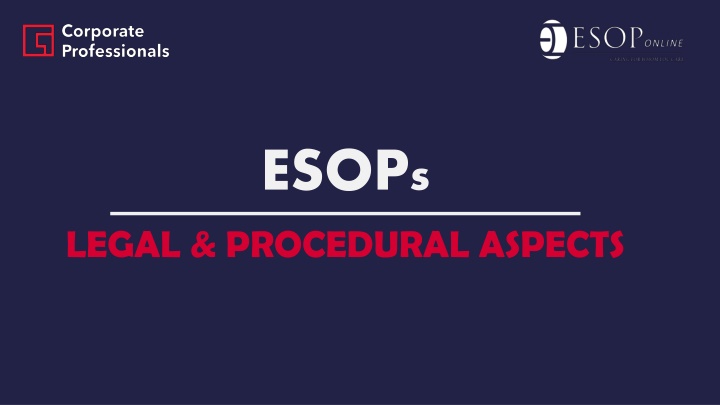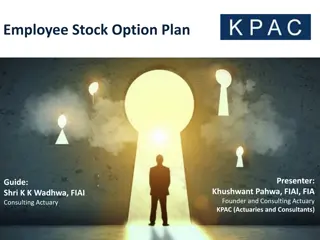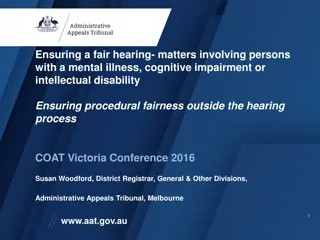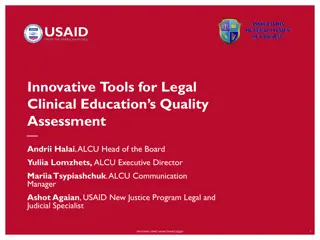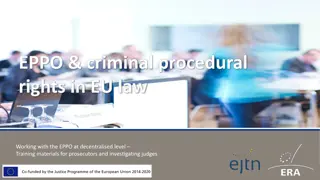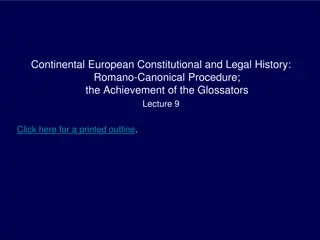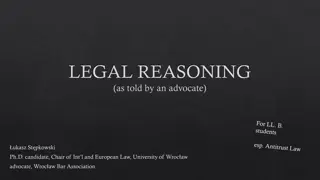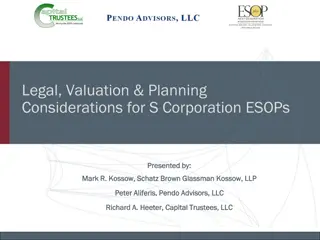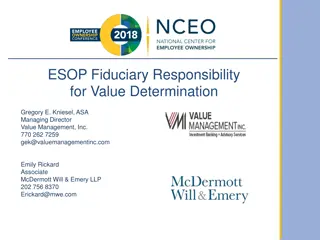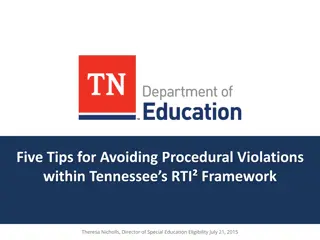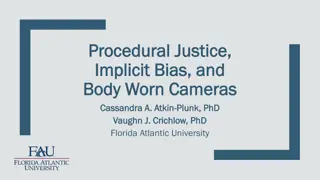ESOPs Legal & Procedural Aspects
Employee Stock Option Plans/Equity Incentive Plans (ESOPs) are crucial tools for attracting, motivating, and retaining employees through equity-based compensation. ESOPs offer various modes of restructuring and key terms to understand such as grant, vesting, and exercise. Companies also provide ESOPs, ESPPs, and RSUs as part of their compensation packages to align employee interests with company goals.
Download Presentation

Please find below an Image/Link to download the presentation.
The content on the website is provided AS IS for your information and personal use only. It may not be sold, licensed, or shared on other websites without obtaining consent from the author.If you encounter any issues during the download, it is possible that the publisher has removed the file from their server.
You are allowed to download the files provided on this website for personal or commercial use, subject to the condition that they are used lawfully. All files are the property of their respective owners.
The content on the website is provided AS IS for your information and personal use only. It may not be sold, licensed, or shared on other websites without obtaining consent from the author.
E N D
Presentation Transcript
ESOPs LEGAL & PROCEDURAL ASPECTS
EMPLOYEE STOCK OPTIONS Employee Stock Option Plans/Equity Incentive Plans (commonly referred to as ESOPs) are one of the most important tools to attract, encourage and retain Employees. It is the mechanism by which employees are compensated with increasing equity interests over time. Company grants an option to its Employee to acquire Equity Shares of the company at a future date and at predetermined price. There is no limit on quantum of ESOPs to be issued to employees Owners Employees
WHY ESOPs? Attract, Reward, Motivate and Retain Employees Enhances job satisfaction Deferred compensation strategy Good retirement benefit plan Employee aligns with company s goals
RESTRUCTURING MODES UNDER ESOP Employee Stock Option Plans (ESOP) Employee Stock Purchase Plan (ESPP) Restricted Stock Units (RSU) Stock Appreciation Rights Equity Settled (SAR-Equity Settled) Stock Appreciation Rights Cash Settled (SAR-Cash Settled)
MAJOR TERMS TO UNDERSTAND Grant: Offering of ESOP Options from Company to Employee Vesting: Process through which employee becomes eligible to exercise options Exercise: When employee applies to Company for getting shares allotted
EMPLOYEE STOCK OPTION PLAN (ESOP) It is a right offered by a company to its employees to take equity shares of company at discounted price. Grant of options Vesting of options Exercise of Vested options Allotment of Shares Example of Companies Offering ESOPs:
EMPLOYEE STOCK PURCHASE PLANS (ESPP) It allows Employee to purchase Company s shares, often at a discount from Fair Market Value. Offer of shares at discounted price If accepted by the Employee Allotment of shares Example of Companies Offering ESPPs:
RESTRICTED STOCK UNITS (RSU) Employee is awarded with the shares subject to fulfillment of certain underlying conditions. Exercise of Vested options Grant of options Vesting of options Allotment of shares Underlying Conditions like: - Target / Revenue - Performance based etc. If Condition fulfilled Example of Companies Offering RSUs:
STOCK APPRECIATION RIGHTS (SAR) In case of SARs employee gets the benefit in the form of cash / equity which is the difference between the date of grant and final exercise of options. Exercise of Vested Options Grant of Options Vesting of Options Share price on Grant Rs 10 Share price on Exercise Rs 100 Shares Appreciation = Rs. 90/- Cash Example of Companies Offering SARs:
ESOP IMPLEMENTING MODES Direct Route Trust Route
DIRECT ROUTE Direct Route 1 Options to buy shares 2 Exercise of options Company Employee 3 Issue of shares
TRUST ROUTE Trust Route 1 4 Grant of Loan for Payment of subscription Money Employee Welfare Trust Exercise of options 6 5 Repayment of Loan Transfer of Shares Company Employee 2 Direct Issue of Shares 3 Issue of options
FAQs- TRUST ROUTE 1. Does giving loan to Trust for ESOP purpose, by a Company attracts Sec. 186 of Companies Act, 2013? No. It is allowed under Sec. 67 of CA, 2013, only if it is given for ESOP purpose. 2. What are the tax implications in case of Trust Route? - - - Capital Gain tax at the time of sale of shares On Company : No tax liability On Trust : Capital Gain / Loss at the time when Trust transfer shares to employees On Employees : Perquisite tax at the time of exercise of options 3. In which category the Trust is shown in the SHP of listed company? Non-Promoter Non-Public Category
FAQs- TRUST ROUTE 4. Who can become the Trustee of ESOP Trust? - For Private Companies : Anyone can be a Trustee - For Public Unlisted & Listed Companies : Anyone can be a Trustee except a person: 1. is a director, key managerial personnel or promoter of the company or its holding, subsidiary or associate company or any relative of such director, key managerial personnel or promoter; or 2. beneficially holds ten percent or more of the paid-up share capital of the company.
SEBIs INFORMAL GUIDANCE: In the matter of Capital Trust Ltd. - SEBI held that, since the Trustees do not have any voting rights on the Equity Shares held by an ESOP Trust, - Therefore, the shares held by the Trust will not be counted as part of company s capital for the purpose of determining the voting rights as per the SEBI (SAST) Regulations, 2011. Category No. of Shares Percentage No. of Shares Percentage Promoter1 24 24% 24 25.26% Promoter2 46 46% 46 48.42% Public 25 25% 25 26.32% ESOP Trust 5 5% 0 Total 100 100% 95 100
COVERAGE OF EMPLOYEES Employees Covered Defined under Regulation 2(f) of Not Covered SEBI (SBEB) Regulations, 2014 Of Company, its holding & subsidiaries + Foreign employees
FAQs- COVERAGE OF EMPLOYEES 1. Coverage of Group Company employees? - Holding Company : Covered Separate approval of shareholders required - Subsidiary Company : Covered - Separate approval of shareholders required - Associate Company : Cannot be covered - Joint Venture : Cannot be covered - Group Company : Cannot be covered
WHAT COMPANYS SEE WHILE GRANTING ESOPs Loyalty Performance Designation Present & Potential Contribution Opportunity Cost
REGULATORY FRAMEWORK Listed Company Unlisted Company When Foreign Employee are covered SEBI (SBEB) Regulations, 2014 (Applicable for Listed + Unlisted) Companies Act, 2013 + Rules SEBI (LODR) Regulations, 2015 Income Tax Act, 1961 Foreign Exchange Management Act, 1999 SEBI (PIT) Regulations, 2015 Income Tax Act, 1961
FAQs - FEMA 1. What are the FEMA provisions that are applicable on issuing ESOPs to foreign employees? - Now there is no limit on %age of capital which can be issued as ESOP to foreign employees. - Companies need to adhere the provisions of CA, 2013/ SEBI Regulations, as the case may be, while issuing ESOPs outside India. - Companies falling under Approval Route need to obtain prior approval for issuing ESOPs - Form ESOP is required to be filed with AD-Bank within 30 days of Grant of Options - Form FC-GPR to be filed with AD-Bank within 30 days of allotment of shares
HOW TO ISSUE ESOPs? Board Meeting General Meeting Grant of options Vesting period Exercise of option by an employee Allotment of shares to the Employees
PRICING CRITERIA BASE FOR PRICE Unlisted Company Listed Company A price calculated on the basis of valuation done upon Grant. Market price, one day before the date of Grant - Companies are free to decide the Exercise price, - discount / premium over it however, - the Exercise price shall never go below the Par Value of Shares
ACCOUNTING ASPECTS REGULATORY FRAMEWORK Ind-As 102 / ICAI Guidance Note 18 Employee Compensation Expense (equivalent to Price Discount)= Market Value- Price at which Shares are offered Allowable Expense during the relevant Accounting Period in which the Shares are issued. Example : Direct Impact on Profit & Loss Account Current Value Rs.55/- Offer price is Rs.10/- Then Price Discount/ Employee Compensation Expense to be booked is Rs.44/-.
TAX TREATMENT Example : (Capital Gain Tax) TAX TREATMENT Sale value :- Rs.120/- Holding period less than 1 year Short Term Capital Gain Gain Value: - (Rs.120 Rs.100) = Rs.20 Tax @ 15% :- Rs.3/- FOR EMPLOYEES Example : (Perquisite Tax) In the hands of Employee FMV on Exercise :- Rs.100/- Exercise Price :- Rs.10/- Perquisite Value :- (Rs.100 Rs.10) = Rs.90/- Tax @ Rs.20% :- Rs.18/- At the time of transfer of shares; At the time of Allotment: Taxable Value= FMV on the date of exercise of options-Exercise Price Taxable Value= Sales Price of Shares-FMV of shares at the time of Exercise
TAX TREATMENT FOR COMPANY Company has no tax liability, it has to book Compensation Cost in its P&L Account - Point of Calculation : Grant - Period of Booking : Over vesting period Decided Judgements: CIT vs. Lemon tree Hotels Ltd. , August, 2015: It was decided that expense incurred by employer is allowable & can be debited from P&L account of company. CIT(A) vs. People Interactive India Pvt. Ltd. , October, 2015: It was decided that discount under ESOP is in the nature of employee cost and hence is deductible during the vesting period.
COMPARATIVE ANALYSIS Employee Stock Employee Stock Purchase Purchase Plan(ESPP) Plan(ESPP) helps best meet below objectives Employee Stock Employee Stock Options Plan( Options Plan(ESOP) Stock Appreciation Stock Appreciation Rights(SAR) Rights(SAR) Restricted Stock Restricted Stock Unit( Unit(RSU) RSU) Parameters Parameters ESOP) Which Which helps best meet below objectives Alignment with Alignment with Company Goals Company Goals High High High High Medium Medium High High High High Reward Reward Medium Medium Medium Medium Medium Medium High High Retention Retention Medium Medium Medium Medium High High Employee Employee Preference Preference High High High High Medium Medium High High
ESOP & MANAGERIAL REMUNERATION Whether ESOP granted to a Director is included in his Managerial Remuneration? - Yes - ESOP is a perquisite & perquisites are included in remuneration. Hence ESOP becomes part of MR of a Director - Trigger point is exercise of options - Example: Perquisite Value Rs.200/- Number of Options Exercised 50,000 Total Perquisite value Rs.1,00,00,000 (Added to the MR of the year of exercise) Limit on MR in a Financial Year 5% of Net Profit Rs. 1,00,00,000 is exceeding the limit then CG approval is required.
ESOP & INSIDER TRADING REGULATIONS Restrictions of Trading window closure On Exercise :Not Applicable On Sale : Applicable Restrictions of Contra-trade Not Applicable Requirement of Pre-clearance On Exercise :Not Applicable On Sale : Applicable on Designated Employee having UPSI Disclosure Requirements Applicable
EXIT MECHANISM FOR UNLISTED CO. Employee can surrender his shares at any of the following events: Listing of Company Private Equity Investment Investment by NRIs, VCs & HNIs Merger, de-merger, acquisition, consolidation, split, sale of business or dissolution of the company The sale, lease or exchange of all or substantially all of the assets or undertaking of the Company.
VALUATION ASPECTS For ESOPs, there are basically 2 types of Valuations: Accounting Valuation: This Valuation is required for calculating Employee Compensation Cost during the vesting period. Accounting valuation can be performed by any valuer Perquisite Valuation: This Valuation would be conducted only in case of unlisted Companies, at the time of Exercise of Options by the Employee to know the value of the perquisite in employee s hands. Perquisite valuation is performed by Merchant Banker
CHALLENGES FOR ESOPs Budget 2017-18 Finance Ministry has withdrawn the exemption from Long-term Capital Gain tax arising on transfer of listed shares in case Securities Transaction Tax has not been paid at the time of acquisition of shares. ESOP in a fresh allotment (excluding the secondary market acquisitions ) where payment of STT at the time of acquisition of shares cannot be paid by the employees. This will lead to hardships on employee as he has to pay LTCG on transfer of shares which was earlier exempt under Section 10(38) of Income Tax Act, 1961.
ESOPs FOR START-UPs Startups are cash-short, therefore ESOP is the best way to compensate employees Employees will get aligned to the interest of company To motivate ESOPs in Startups, Government has even allowed to offer ESOPs to Promoters & Directors holding more than 10% of the outstanding equity share capital of the company which is otherwise not allowed. HELPFUL TOOL IN CASH-CRUNCH ESOPs can also prove to be a great tool at times of economic slow down where companies are low at cash, however at the same time motivating employees is important. They can do so by offering them equity.
ESOPs IN PUBLIC SECTOR ESOPs, also welcomed by Public Sector Department of Public Enterprises Guidelines provide that 10%-25% of performance related pays should be paid in the form of ESOPs. First implemented by NALCO Even the Finance Ministry has given its nod to ESOPs in Public Sector Banks. Final implementation stuck on decision of Bank Board Bureau.
SWEAT EQUITY- Another way to reward Star Performers Rewarded for: - Value Addition - IPR - Technical know-how Eligibility: - Promoter Directors - Other Directors - Permanent Employees Lock-in: - 3 years fro date of allotment Pricing: - Free of Cost - Cash consideration - Non-cash consideration - Valuation to be done by Registered Valuer
CHECK POINTS FOR SWEAT EQUITY Special resolution valid for 12 months At least one year must have elapsed since the date on which the Company had commenced business. Annual Limit: 15% of existing paid-up equity share capital in a year or shares of issue value of Rs. 5cr, whichever is higher Overall Limit: 25% of the paid-up equity capital Accounting Treatment: - Becomes MR : If Charged to P&L Account directly - Not become MR : If consideration takes form of amortizable asset
D-28, South Extn. Part- I, New Delhi 110049 F: +91 1140622201 T: +91 1140622200 www.corporateprofessionals.com
